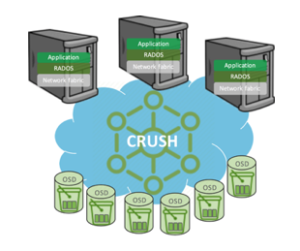Storage analysts forecast the global software defined storage (SDS) market to grow at a CAGR of 31.6% during the period 2016-2020. While customers are drawn to its attractive Total Cost of Ownership (TCO), SDS solutions should also offer the following three benefits:
- Commercial off-the-shelf (COTS) hardware
- Seamless capacity and performance scaling
- Convergence of block, file, and object
MediaScale Storage™ Storage provides all of these attributes and also features an innovative way for clients and applications to access their data called the client-cluster model.
The Legacy Client-Server Model
Since the early days of storage system architecture, the connections between servers and storage have been point-to-point. As storage systems scaled up by adding ports, “multi-pathing” layers hid the complexity of multiple physical connections so that client servers believed they still only had a single point-to-point connection. Even a large Storage Area Networking (SAN) storage system with 100’s of Fibre Channel ports still presented point-to-point connections to each server. In the world of storage infrastructure, the complexities and pitfalls of dealing with multi-pathing technologies such as MPIO, ALUA, NPIV, and others are well known.

MediaScaleX // Storage
The Modern Client-Cluster Model
With MediaScale Storage, data is organized into objects to enable a client-cluster model. Each member of the cluster is aware of the location of objects through a consistent hashing protocol called CRUSH (Controlled Replication Under Scalable Hashing). Each cluster member locates objects within the cluster themselves and object locations are resolved down to single drives using a process known as OSD (Object Storage Daemon).
CRUSH spreads data evenly across the participating disks (OSDs) in the cluster so all cluster resources are fully utilized. It also allows databases and applications to know the exact location of data, including the backup location of objects during failures, without having to check with other nodes.
MediaScale Storage Leverages the Client-Cluster Model
Taking full advantage of the Client-Cluster model, MediaScale Storage has developed an optimized Reliable Autonomic Distributed Object Store (RADOS) interface, AQR, that intelligently locates and retrieves visual & media streaming assets.
Origin applications that utilize this protocol can automatically and directly access new resources as storage nodes (servers with disks and CPU) are added to the MediaScale Storage cluster, with data relocating to utilize the new disks and servers. Similarly, when an additional Origin server is added, it is automatically aware of all content data, the location of that data, and how to access it.
The recent release of MediaScale Storage 3.0 adds the new High Availability feature, providing continuous access to files using two MediaScale Storage Services Nodes so clients can continue to access data should one services node fail.
Summary
One of the exciting benefits of software defined storage is the way that applications access and consume the storage. MediaScaleX // Storage is based on a modern software-defined storage platform that takes full advantage of the Client-Cluster model – providing a superior alternative to the Client-Server model of DAS or SAN.
Back to all resourcesGet Started with Vecima
We help our customers evolve their networks with cloud-based solutions that deliver ground-breaking speed, superior video quality, and exciting new services to their subscribers.
Contact Us

